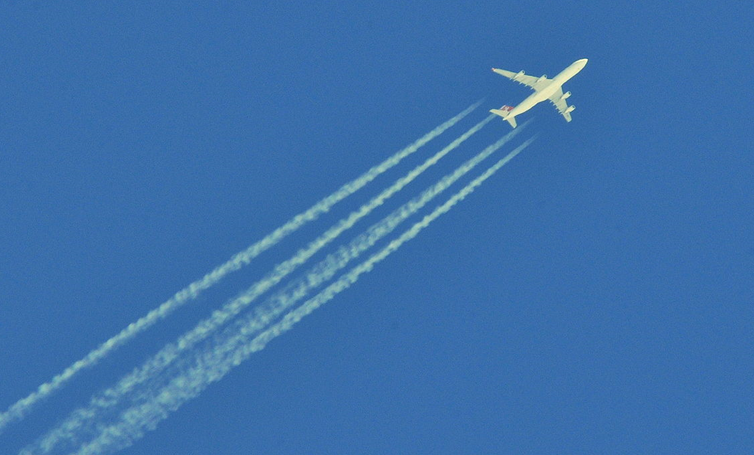Airplane Contrails Could Be a Potent Global Warming Agent

Image Courtesy: Wikipedia
Airplane contrails – the long clouds that they paint in the sky – could have bigger warming effect which is set to triple by 2050, according to a latest finding. The aviation industry has long been criticised for its climate-warming carbon emissions.
Airplanes, flying high in the thin, cold air, create the mesmerising contrails. Water vapour condenses and surrounds the soot from the plane’s exhaust and freezes to form cirrus clouds. These clouds can last for minutes or hours up above the sky. These high-flying clouds are very thin to reflect sunlight, but the tiny ice crystals inside them can trap heat. These contrail clouds, unlike the low-level clouds that have a cooling effect, warm the climate.
Back in 2011, Burkhardt et al, in their seminal paper in Nature, reported that these contrail clouds contribute more to climate warming than all the carbon dioxide produced by planes since the aviation industry has begun. Contrail clouds contribute to the climate warming through a process known as radiative forcing. Radiative forcing effects of contrail cirrus are felt for much shorter time span (a few decades) compared to the impact of carbon dioxide (a few thousand years). And these effects are predicted to get worse as air traffic is projected to increase in times to come. Some estimates suggest that global air traffic is going to quadruple by the year 2050.
One of the researchers of the 2011 Nature paper, Ulrike Burkhardt from the German Aerospace Center’s (DLR’s) Institute for Atmospheric Physics in Wessling created a new climatic model, which, for the first time, categorised contrail clouds separately from the natural clouds. This categorisation helped them to model the particular qualities of the human made cloud.
The researchers modeled the effect of global contrail cloud coverage as per the data in 2006. They could get accurate aviation data. Then, based upon the estimates of future global aviation traffic, they modeled the effect of contrail clouds for 2050. They found that a threefold increase in the warming effect due to contrail clouds is very likely.
The research also looked into another aspect. They found that with a 50% reduction in airplane soot, emissions could lead to a 15% decrease in the contrail clouds’ atmospheric warming effect. High levels of soot contribute to more and longer living contrail clouds, which has the potential to alter weather and climate at the surface. Even a 90% reduction in soot emission with the help of cleaner aircraft fuel would fail to bring contrail cloud’s climate effect back to the level in 2006.
Burkhardt says—“A more likely scenario is that levels of soot and contrail cirrus clouds will continue to rise. That’s because most aviation regulations and pollution-reduction plans fail to consider the climate impact from anything other than carbon dioxide emissions. A United Nations scheme, for example, requires all signatory nations to keep their carbon dioxide emissions under a certain level, and report them annually, but says nothing about the climate impact from contrails.”
One solution according to Burkhardt could be rerouting the flights. But such an effort could lead to more burning of fuels in some cases and hence more carbon dioxide emissions. In that scenario, it would be better to find out fuels that emit less soot. But with the likelihood of increase in air traffic, even that might not be enough.
Get the latest reports & analysis with people's perspective on Protests, movements & deep analytical videos, discussions of the current affairs in your Telegram app. Subscribe to NewsClick's Telegram channel & get Real-Time updates on stories, as they get published on our website.














